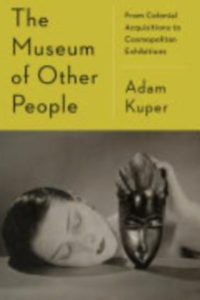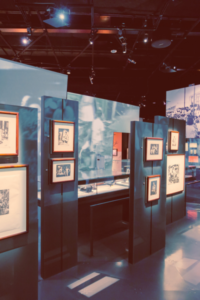Book Review: The Museum of Other People by Adam Kuper
 The Museum of Other People, by Adam Kuper, explores many issues, debates, and controversies surrounding modern museums. These issues aren’t exactly new but are more timely than ever in an age when identity politics enters so many conversations.
The Museum of Other People, by Adam Kuper, explores many issues, debates, and controversies surrounding modern museums. These issues aren’t exactly new but are more timely than ever in an age when identity politics enters so many conversations.
Why Are Museums Controversial?
If you aren’t in a field such as anthropology or embroiled in discussions involving identity politics, you might not be aware that museums have been controversial for the last few decades.
Part of this has to do with the way artifacts were acquired. The modern museum is a relatively recent invention, with roots closely connected to colonial empires such as England and France in the 19th century. Napoleon, for example, seized large numbers of Egyptian items that were put on display.
However, it’s not only items that were seized by force that are considered colonial booty. Many activists now question whether objects purchased from natives were legitimately acquired due to imbalances in power and economic pressure. Kuper doesn’t offer any simple solutions but outlines some of the history and debates that have sprung up in the last couple of centuries.
The Troubling History of Acquisitions
Kuper describes how many leading museums, such as the Louvre, the British Museum, and the Smithsonian first acquired their collections. This type of history inevitably brings up some uncomfortable truths, such as the casually superior attitudes of European and American explorers and collectors had towards native people in Africa, the South Pacific, and the Americas.
He also delves into some less controversial but, at times, equally disputed areas, such as opposing theories on how museums should categorize items. For example, some exhibits place objects together based on the materials used to make them, how they were used (e.g. weapons, eating utensils), and part of the world where they were made.
Restitution and Reparations?
The notion of restitution is often heard in politics today, most commonly in the context of whether the ancestors of slaves are entitled to compensation. The issue is also relevant to artifacts that ended up in European and American museums. As Kuper points out, establishing who has the right of ownership over antique objects is anything but simple. In Africa, for example, certain leaders collaborated with European slave traders. Modern Nigeria is used as an example of a very corrupt modern society where exhibited items are often stolen (with the help of museum staff and political insiders).
There are also differing opinions within groups on how restitution should work, if at all. A country that claims the right to certain artifacts, for example, may not have even existed in its modern form when the items were first acquired. Kuper is skeptical of the sometimes unscientific methods used to verify the history of objects. For example, shamans are sometimes consulted. He rhetorically asks, “Are certain kinds of knowledge encoded in racial memory?”
“Civilized” vs “Primitive” Societies
Fields such as anthropology and ethnography, like museums, began in modern Europe. In the 19th century, it was not controversial to label non-European cultures as primitive or savage. The world beyond Europe and America was assumed to be in a lower state, which conveniently justified practices such as slavery and colonialism.
Museums were largely founded to exhibit the exotic and primitive. Over the years, the terminology used to describe “other” cultures (hence Kuper’s Museum of Other People designation) has been hotly debated. Today, the way items and exhibits are presented can be a very sensitive topic.
Identity Museums
Kuper explores the modern notion of identity museums, mentioning two examples in Washington, DC: The National Museum of the American Indian (NMAI) and the National Museum of African American History and Culture. One problem with such museums is the sheer complexity of these topics.
He points out that more than 500 native American tribes took part in a ceremony marking the opening of the NMAI. Tribes, in America and elsewhere, are not a static or permanent category any more than modern nation states. Tribes have come and gone, intermarried, and re-formed over the centuries. As a result, exhibitions are almost by necessity oversimplified and distorted.
Kuper quotes a piece by Marc Fisher of the Washington Post, who said about NMAI: “It feels like a trade show in which each group of Indians gets space for its founding myth and favourite anecdotes of survival. Each room is a sales booth of its own, separate, out of context.”
A Call For a Cosmopolitan Museum

The final chapter, The Cosmopolitan Museum, is where Kuper argues for the type of developments he’d like to see in the future.
“We must imagine a Cosmopolitan Museum, one that transcends ethnic and national identities, makes comparisons, draws out connections, tracks exchanges across political frontiers, challenges boundaries: a museum set in the shifting sands of the past and the present but which is informed by rigorous critical, independent scholarship.”
“The myth of one person, one tribe, never made much sense. The local cannot be curtained from the global. Every human society is hybrid, a dynamic amalgam of traditions and populations. Although some nativists may deny it, we are all multicultural even cosmopolitan.”
In earlier times, these would not have been controversial opinions. In an age when every public comment or artistic expression is scrutinized by the standards of identity politics (which are themselves highly contested among different individuals, disciplines, and groups), this is a radical statement of classical liberalism.
What is the Future of Museums?
Museums are largely holdover from 19th century colonialism and now inhabit an ambiguous and contentious space. Of course, this refers to museums that display old artifacts and not modern museums dedicated to science, aviation or other more recent innovations.
Kuper argues for a kind of middle ground that recognizes historical issues such as slavery and colonialism without reducing museums to places where political propaganda and activism. His study also connects with many related topics that are, if anything, even more controversial than museums, such as the meaning of race and ethnicity, the complexity of giving reparations to groups, and how modern countries should deal with historical injustices.
There are no easy answers to these issues but books like The Museum of Other People invite us to look at them from multiple angles.
The Museum of Other People on Amazon
